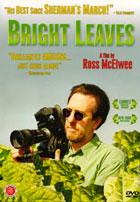 Director: Ross McElwee
Director: Ross McElwee
Duration: 107 minutes
Year: 2003
Key words: Smoking, tobacco, tobacco industry
Summary: Director Rob McElwee returns to his home state, North Carolina (USA), to investigate his family history, the history of tobacco farming and the local community's dependence on the crop.
Degree of public health theme coverage: This a documentary where the director returns to his home state, North Carolina, USA, to investigate his family history, the history of tobacco farming and the local community's dependence on the tobacco crop. It is all done in a highly personal and idiosyncratic sort of way.
The relationship of a whole community to tobacco is shown and the accountability of tobacco farmers for the “global tobacco addiction” is explored. Tobacco farmers are shown as “good” people who go to church and are involved in their local communities. Some are concerned about the effects of the crop and see the link between the tobacco they produce and the harm from smoking. Others (eg, one tobacco farmer, whose mother recently died of lung cancer), see the product and health as completely unrelated.
At the state and industry level there is the contradiction between tobacco's role in the North Carolina economy and the “happy plant” appearance with its negative health effects. North Carolinian silica soil is ideal for growing bright leaf tobacco and it produces a high income per acre (around $3000 per acre gross). This leads to employment for locals because it is a highly labour intensive crop. Thus tobacco is celebrated in many North Carolinian towns for example through an annual Tobacco Festival where a 'Miss Tobacco' is crowned. The strong relationship between the history of tobacco and the history of the USA is also considered. On the industry side is the historical ruthless rivalry amongst early tobacco barons (using the law and perhaps even arson as attack tactics). There is also a bit on how the industry is entwined with health (Duke built a medical school and teaching hospital).
The difficulties of quitting smoking are explored with a couple, who repeatedly struggle to give up smoking. They are shown explaining 'this is the last one (cigarette)' before their wedding, after their honeymoon and then again later. The social aspects of smoking (eg, in settings with friends) is also explored. Score=3/5
Sophistication of analysis of public health content: The aspects of tobacco cover multiple levels (ie, USA as a country, North Carolina, farming communities, the industry, the health sector, families, and individual smokers). The issue of the economic impact of ceasing to produce tobacco on a community and individual level are explored. The director seems fairly open and sympathetic to the diverse range of issues – though some viewers might consider that he is possibly too sympathetic to tobacco given the huge harm associated with this product. Score=3/5
Potential for empowerment and use of advocacy: Smokefree workplaces are shown – which suggests what can even be achieved in the biggest tobacco state (North Carolina). At the end of the movie, the final Tobacco Festival with all the previous “Miss Tobaccos” is shown. This seems to imply some diminishing of the role of tobacco in the community (it is to be replaced by a Farmer's Festival). But it is unclear if this change is due to any advocacy activity. The ambivalence that some of those involved in tobacco production have, might give some hope for future change.
There are few smokers who successfully quit in this movie – which suggests the addictiveness of nicotine. Score=2/5
Persuasiveness of the movie: The director's family history (his great grandfather was once a very successful tobacco baron), gives the director some credibility to explore the issues of smoking and health and community dependence on a hazardous product. He is also an ex-smoker himself so he is aware of how smoking can appeal. He comes across as fairly sincere and interested in exploring many different aspects of tobacco. But at times he seems distracted by playing with movie techniques and with quirky aspects of his family history and issues around memory (that have no relationship to the tobacco theme). Score=2/5
Engagement and cinematic quality: The movie is fairly engaging but the idiosyncratic personal diversions might be a bit irritating to some people. Sometimes the home-movie feel was quite strong – and may have detracted from the overall movie.Score=2/5
Total score = 12/25
Questions for discussion:
- Did the movie director deal with all of the key issues around the problems society has with tobacco?
- How can communities be helped to stop producing harmful substances such as tobacco?
- What were some of the self-exempting beliefs shown in this movie?
Other information:
- There is a published review of this movie (Courtwright DT. Media Reviews: Bright Leaves. Bull. Hist. Med., 2006;80:151-2).
- The Wikipedia entry on this movie is very minimal and no trailer is available.
- Back to Films in Undergraduate Public Health Teaching home page
CONTACT US
Associate Professor Nick Wilson
Department of Public Health
University of Otago, Wellington
PO Box 7343
Wellington South 6242
New Zealand
Tel: +64 4 385 5541 ext 6469
Fax: +64 4 389 5319
Email: nick.wilson@otago.ac.nz